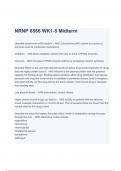NRNP 6566 (NRNP6566)
Walden University
Page 3 out of 262 results
Sort by
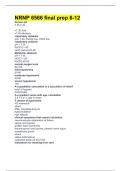
-
NRNP 6566 final prep 6-12
- Exam (elaborations) • 9 pages • 2024
-
- $11.39
- + learn more
NRNP 6566 final prep 6-12 Normal pH 7.35-7.45 <7.35 Acid >7.45 alkalosis respiratory aklalosis pH> 7.45, PaC02 low, HC03 low respiratory acidosis pH < 7.35 PaCO2 > 45 Hc03 normal 22-26 Metabolic alkalosis pH > 7.45 HCO3 > 26 PaC02 45-35 normal oxygen levle 80-100 mild hypoxemia 60-80 moderate hypoxemia 40-60 severe hypoxemia <40 A-a gradiatian calculation is a calculation of what? level of hypoxia PA02-Pa02 A-a gradiant varies with age, calcula...

-
NRNP 6566 Mid-term Study Guide Week 1 to 5
- Exam (elaborations) • 16 pages • 2024
-
- $15.09
- + learn more
NRNP 6566 Mid-term Study Guide Week 1 to 5 Week 1 1. Describe the cytochrome P450 system. Describe how inducers and inhibitors affect the cytochrome system and how that affects the half-life of medications. Cytochromes P450 (CYPs) are a superfamily of enzymes containing heme as a cofactor that function as monooxygenases. In mammals, these proteins oxidize steroids, fatty acids, and xenobiotics, and are important for the clearance of various compounds, as well as for hormone synthesis and br...

-
• NRNP 6566 week 11 knowledge check
- Exam (elaborations) • 9 pages • 2024
-
- $11.09
- + learn more
• NRNP 6566 week 11 knowledge check How would you differentiate between diabetic ketoacidosis (DKA) and hyperosmolar hyperglycemic syndrome (HHS)? Correct Answer: Both of these conditions will include high levels of blood glucose readings. DKA will exhibit acidosis and urinary ketones while HHS will not. Treatment for each condition is similar with fluid bolus and infusion as well as insulin bolus and infusion. Juan is a 42 year old male with complaints of nausea and vomiti...
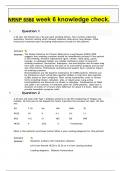
-
NRNP 6566 week 6 knowledge check.
- Exam (elaborations) • 8 pages • 2024
-
- $11.49
- + learn more
NRNP 6566 week 6 knowledge check. A 54 year old female has a 30 year pack smoking history. She recently underwent pulmonary function testing which showed moderate obstructive lung disease. What would your treatment plan (including medications) include for this patient? Correct Answer: The Global Initiative for Chronic Obstructive Lung Disease (GOLD) 2020 suggests that smoking cessation should be immediately pursued if the patient is still smoking. Nicotine replacement (gum, inhal...
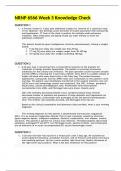
-
NRNP 6566 Week 5 Knowledge Check
- Exam (elaborations) • 4 pages • 2024
-
- $9.49
- + learn more
NRNP 6566 Week 5 Knowledge Check QUESTION 1 1. A 54-year women is 3 days post abdominal surgery for removal of a cancerous mass in her abdomen. She develops acute shortness of breath associated with tachycardia and hypotension. CT Scan of the chest is positive for multiple small pulmonary embolism. What medication and dosing would you order initially to treat the pulmonary embolism? This patient should be given fondaparinuc (Arixtra) subcutaneously. Dosing is weight- based: 1. 5 mg SQ on...
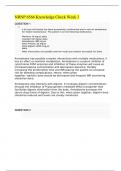
-
NRNP 6566 Knowledge Check Week 3
- Exam (elaborations) • 7 pages • 2024
-
- $9.49
- + learn more
NRNP 6566 Knowledge Check Week 3 Amiodarone has possible complex interactions with multiple medications. It has an effect on warfarin metabolism. Amiodarone is a potent inhibitor of cytochrome P450 enzymes and inhibition of these enzymes will cause an increased plasma concentration and decreased clearance; thereby increasing the prothrombin time and INR placing the patient at increased risk for bleeding complications. Hence, when given together, warfarin dose should be decreased and frequent...
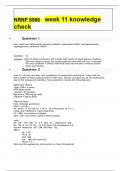
-
NRNP 6566 week 11 knowledge check
- Exam (elaborations) • 9 pages • 2024
-
- $10.99
- + learn more
NRNP 6566 week 11 knowledge check How would you differentiate between diabetic ketoacidosis (DKA) and hyperosmolar hyperglycemic syndrome (HHS)? Correct Answer: Both of these conditions will include high levels of blood glucose readings. DKA will exhibit acidosis and urinary ketones while HHS will not. Treatment for each condition is similar with fluid bolus and infusion as well as insulin bolus and infusion. Juan is a 42 year old male with complaints of nausea and vomiting for...
NRNP 6566 WK1-5 Midterm Exam Latest Update Questions and Answers (A+ GRADED 100% VERIFIED)

-
NRNP 6566 WEEK 11 KNOWLEDGE CHECK 2 LATEST VERSIONS 2023 20 QUESTIONS AND CORRECT ANSWERS AGRADE
- Exam (elaborations) • 15 pages • 2024
- Available in package deal
-
- $10.99
- + learn more
NRNP 6566 WEEK 11 KNOWLEDGE CHECK 2 LATEST VERSIONS 2023 20 QUESTIONS AND CORRECT ANSWERS AGRADE VERSION A How would you differentiate between diabetic ketoacidosis (DKA) and hyperosmolar hyperglycemic syndrome (HHS)? Correct Answer: Both of these conditions will include high levels of blood glucose readings. DKA will exhibit acidosis and urinary ketones while HHS will not. Treatment for each condition is similar with fluid bolus and infusion as well as insulin bolus and infusion. Juan...

How did he do that? By selling his study resources on Stuvia. Try it yourself! Discover all about earning on Stuvia



